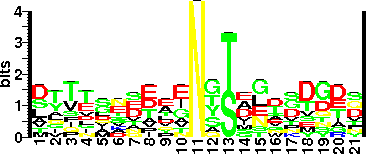
| Technique(s) used for Glycosylation Detection | Periodate-arsenite-Schiff reagent staining and carbohydrate analysis using GC. LC ESI MS, MS/MS |
| Technique(s) used for Glycosylated Residue(s) Detection | Glycopeptide sequencing |
| Protein Glycosylation- Implication | It is the pattern and the chemical nature of the N-linked saccharides which exhibits a drastic change at the transition from moderate to extreme halophily. This different pattern of glycosylation (sulfated glucuronic acids and a repeating unit saccharide) introduces at least 120 additional negative charges into the glycoprotein. The protruding highly negatively charged loops are required for stabilization in high salt concentrations. Thus, the sulfated repeating unit saccharide is required for stabilization of the rod shaped morphology. |
| Glycan Information |
| Glycan Annotation | Linkages: β GalNAc- Asn, Glc-Asn, Gal-Thr.
Total carbohydrate content is approximately 10 to 12% of 200kDa S layer glycoprotein.
N glycosylated (at position N2) with GlcNAc-linked repeating (10-15 repeats) sulfated pentasaccharide and with sulphated oligosaccharides: (GlcA(OSO3-)-[β1→4GlcA(OSO3-)]2-β1→4Glc-Asn) at ten other poistions.
Abut 20 neutral di/ tri- saccharides β-D-Glc-(1→2)-Gal-(1→ or (uronic acid, glucose)-galactose are O-glycosidically attached to clustered threonine residues (14) adjacent to the TM domain at the C terminus but precise position of O glycosylated residues is not known.
A tetrasaccharide comprising a hexose as the linking sugar, a sulfated hexuronic acid at position 2, a hexuronic acid at position 3 and a second sulfated hexuronic acid at position 4 |
| BCSDB ID | 136320 |
| GlyTouCan | G81788YA |
| Technique(s) used for Glycan Identification | GC-MS (gas chromatography-mass spectrometry) analysis of peracetylated alditols. |
| Protein Glycosylation linked (PGL) gene(s) |
| OST Gene Name | AglB/STT3 subunit |
| OST ProGT ID | ProGT80 |
| Additional Comment | First prokaryotic glycoprotein that was charcterized experimentally for the site of glycosylation as well as glycan attached. The features unique to N glycosylation in H salinarium are: the majority of glycans are linked via glucose instead of GlcNAc or GalNAc to the Asn in protein. Presence of sulfated oligosaccharides that bind to a C60-dolichol monophosphate carrier lipid. Protein associated glycans differ mainly in terminal sugars. S layer proteins of H salinarium and H. volcanii are the examples of a lesser understood and rare type of glycosylation namely O glycosylation in Archaea. A cluster of 14 threonine residues (yet uncharacterized) present at hydrophobic C terminus membrane anchor has also been reported glycosylated with glucosylgalactose disaccharides in S layer glycoprotein of H salinarium. Bacitracin inhibits growth of Halobacteria.
Sequon features: excluding the only unique Asn-GalNAc site, all sequon sequences are preceded by 1 or even 2 negatively charged amino acid residues. |
| Literature |
| Year of Identification | 1974 |
| Year of Identification Month Wise | 1974 |
| Year of Validation | 1987 |
| Reference | Mengele, R. and Sumper, M., 1992. Drastic differences in glycosylation of related S-layer glycoproteins from moderate and extreme halophiles. Journal of Biological Chemistry, 267(12), pp.8182-8185. |
| Corresponding Author | Manfred Sumper |
| Contact | Chair of Biochemistry I, University of Regensburg, Federal Republic of Germany |
| Reference | Lechner, J. and Sumper, M., 1987. The primary structure of a procaryotic glycoprotein. Cloning and sequencing of the cell surface glycoprotein gene of halobacteria. Journal of Biological Chemistry, 262(20), pp.9724-9729. |
| Corresponding Author | Manfred Sumper |
| Contact | Chair of Biochemistry I, University of Regensburg, Federal Republic of Germany |
| Reference | Lechner, J., Wieland, F. and Sumper, M., 1985. Transient methylation of dolichyl oligosaccharides is an obligatory step in halobacterial sulfated glycoprotein biosynthesis. Journal of Biological Chemistry, 260(15), pp.8984-8989. |
| Corresponding Author | Felix Wieland |
| Contact | Dept. of Biochemistry, Stanford University School of Medicine, Stanford University Medical Center, Stanford, CA 94305. |
| Reference | Paul, G., Lottspeich, F. and Wieland, F., 1986. Asparaginyl-N-acetylgalactosamine. Linkage unit of halobacterial glycosaminoglycan. Journal of Biological Chemistry, 261(3), pp.1020-1024. |
| Corresponding Author | Felix Wieland |
| Contact | Dept. of Biochemistry, Stanford University School of Medicine, Stanford University Medical Center, Stanford, CA 94305. |
| Reference | Wieland, F., Paul, G. and Sumper, M., 1985. Halobacterial flagellins are sulfated glycoproteins. Journal of Biological Chemistry, 260(28), pp.15180-15185. |
| Corresponding Author | Felix Wieland |
| Contact | Dept. of Biochemistry, Stanford University School of Medicine, Stanford University Medical Center, Stanford, CA 94305. |
| Reference | Wieland, F., Heitzer, R. and Schaefer, W., 1983. Asparaginylglucose: novel type of carbohydrate linkage. Proceedings of the National Academy of Sciences, 80(18), pp.5470-5474. |
| Corresponding Author | Felix Wieland |
| Contact | Dept. of Biochemistry, Stanford University School of Medicine, Stanford University Medical Center, Stanford, CA 94305. |
| Reference | Mescher, M.F., Strominger, J.L. and Watson, S.W., 1974. Protein and carbohydrate composition of the cell envelope of Halobacterium salinarium. Journal of Bacteriology, 120(2), pp.945-954. |
| Corresponding Author | Jack L Strominger |
| Contact | Biological Laboratories, Harvard University, Cambridge, Massachusetts 02138 |
| Reference | Wieland, F., Dompert, W., Bernhardt, G. and Sumper, M., 1980. Halobacterial glycoprotein saccharides contain covalently linked sulphate. FEBS letters, 120(1), pp.110-114. |
| Corresponding Author | Felix Wieland |
| Contact | Dept. of Biochemistry, Stanford University School of Medicine, Stanford University Medical Center, Stanford, CA 94305. |
| Reference | Vershinin, Z., Zaretsky, M., Guan, Z. and Eichler, J., 2021. Revisiting N-glycosylation in Halobacterium salinarum: Characterizing a dolichol phosphate-and glycoprotein-bound tetrasaccharide. Glycobiology. |